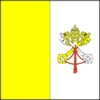NAVIGATION
|
HOME
• FLAG FINDER
• MAP FINDER
• SOURCES
• ADD YOURSELF TO THE ATLAS! COUNTRIES A-D • COUNTRIES E-K • COUNTRIES L-R • COUNTRIES S-Z |
NAVIGATION

The Holy See (State of the Vatican City)
Santa Sede (Stato della Citta del Vaticano)



GOVERNMENT
|
Country name:
|
conventional long form: The Holy See (State of the Vatican City)
conventional short form: Holy See (Vatican City) local short form: Santa Sede (Citta del Vaticano) local long form: Santa Sede (Stato della Citta del Vaticano) |
|
Government type:
|
ecclesiastical |
|
Capital:
|
Vatican City |
|
Administrative divisions:
|
none |
|
Independence:
|
11 February 1929 (from Italy)
note: on 11 February 1929, three treaties were signed with Italy which, among other things, recognized the full sovereignty of the Vatican and established its territorial extent; however, the origin of the Papal States, which over the years have varied considerably in extent, may be traced back to the 8th century |
|
National holiday:
|
Coronation Day of Pope JOHN PAUL II, 22 October (1978) |
|
Constitution:
|
Apostolic Constitution of 1967 (effective 1 March 1968) |
|
Legal system:
|
based on Code of Canon Law and revisions to it |
|
Suffrage:
|
limited to cardinals less than 80 years old |
|
Executive branch:
|
chief of state: Pope JOHN PAUL II (since 16 October 1978)
head of government: Secretary of State Cardinal Angelo SODANO (since 2 December 1990) cabinet: Pontifical Commission appointed by the pope elections: pope elected for life by the College of Cardinals; election last held 16 October 1978 (next to be held after the death of the current pope); secretary of state appointed by the pope election results: Karol WOJTYLA elected pope |
|
Legislative branch:
|
unicameral Pontifical Commission |
|
Judicial branch:
|
there are three tribunals responsible for civil and criminal matters within Vatican City; three other tribunals rule on issues pertaining to the Holy See
note: judicial duties were established by the Motu Proprio of Pius XII on 1 May 1946 |
|
Political parties and leaders:
|
none |
|
Political pressure groups and leaders:
|
none (exclusive of influence exercised by church officers) |
|
International organization participation:
|
CE (observer), IAEA, ICFTU, IOM (observer), ITU, NAM (guest), OAS (observer), OPCW, OSCE, UN (observer), UNCTAD, UNHCR, UPU, WHO (observer), WIPO, WToO (observer), WTrO (observer) |
|
Diplomatic representation in the US:
|
chief of mission: Apostolic Nuncio Archbishop Gabriel MONTALVO
FAX: [1] (202) 337-4036 telephone: [1] (202) 333-7121 chancery: 3339 Massachusetts Avenue NW, Washington, DC 20008 |
|
Diplomatic representation from the US:
|
chief of mission: Ambassador R. James "Jim" NICHOLSON
embassy: Villa Domiziana, Via delle Terme Deciane 26, 00162 Rome mailing address: PSC 59, Box F, APO AE 09624 telephone: [39] (06) 4674-3428 FAX: [39] (06) 5758346 |
|
Flag description:
|
two vertical bands of yellow (hoist side) and white with the crossed keys of Saint Peter and the papal miter centered in the white band |
ECONOMY
|
Economy - overview:
|
This unique, noncommercial economy is supported financially by an annual tax on Roman Catholic dioceses throughout the world, as well as by special collections (known as Peter's Pence); the sale of postage stamps, coins, medals, and tourist mementos; fees for admission to museums; and the sale of publications. Investments and real estate income also account for a sizable portion of revenue. The incomes and living standards of lay workers are comparable to those of counterparts who work in the city of Rome. |
|
Population below poverty line:
|
NA% |
|
Household income or consumption by percentage share:
|
lowest 10%: NA%
highest 10%: NA% |
|
Labor force:
|
NA |
|
Labor force - by occupation:
|
essentially services with a small amount of industry; note - dignitaries, priests, nuns, guards, and 3,000 lay workers live outside the Vatican |
|
Budget:
|
revenues: $173.5 million
expenditures: $176.6 million, including capital expenditures of $NA (2001) |
|
Industries:
|
printing; production of coins, medals, postage stamps, a small amount of mosaics and staff uniforms; worldwide banking and financial activities |
|
Electricity - production:
|
NA kWh |
|
Electricity - consumption:
|
NA kWh |
|
Electricity - imports:
|
NA kWh; note - electricity supplied by Italy |
|
Economic aid - recipient:
|
none |
|
Currency:
|
euro (EUR) |
|
Currency code:
|
EUR |
|
Exchange rates:
|
euros per US dollar - 1.0626 1.1324 (2002), 1.1175 (2001), 1.0854 (2000), 0.9386 (1999) |
|
Fiscal year:
|
calendar year |
